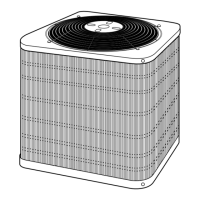• 3-phase scroll compressors are rotation sensitive.
• A flashing LED on phase monitor indicates reverse rotation.
(See Fig. 10 and Table 3.)
• This will not allow contactor to be energized.
• Disconnect power to unit and interchange 2 field wiring
leads on unit contactor.
Follow these steps to properly start up the system.
1. After system is evacuated, fully back seat (open) liquid and
vapor service valves.
2. Unit is shipped with valve stem(s) front seated (closed) and
caps installed. replace stem caps after system is opened to
refrigerant flow. Replace caps finger-tight and tighten with
wrench an additional 1/12 turn.
3. Close electrical disconnects to energize system.
4. Set room thermostat at desired temperature. Be sure set point
is below indoor ambient temperature.
5. Set room thermostat to COOL and fan control to ON or AUTO
mode, as desired. Operate unit for 15 minutes Check system
refrigerant charge.
SEQUENCE OF OPERATION
Turn on power to indoor and outdoor units. Transformer is
energized.
On a call for cooling, thermostat makes circuits R-Y and R-G. On
three phase models with scroll compressors, the units are equipped
with a phase monitor to detect in the incoming power is correctly
phased for compressor operation. If the phasing is correct, circuit
R-Y energizes contactor, starting outdoor fan motor and compres-
sor circuit. R-G energizes indoor unit blower relay, starting indoor
blower motor on high speed.
NOTE: If the phasing is incorrect, the contactor will not be
energized. To correct the phasing, interchange any two of the three
power connections on the field side.
When thermostat is satisfied, its contacts open, de-energizing
contactor and blower relay. Compressor and motors stop.
If indoor unit is equipped with a time-delay relay circuit, the
indoor blower runs an additional 90 sec to increase system
efficiency.
Step 12—Check Charge
UNIT CHARGE
Factory charge and charging method are shown on unit informa-
tion plate. Charge Puron® units using a commercial-type metering
device in manifold hose. Charge refrigerant into suction line.
NOTE: If superheat or subcooling charging conditions are not
favorable, charge must be weighed in accordance with unit rating
plate ± 0.6 oz/ft of 3/8-in. liquid line above or below 15 ft
respectively.
EXAMPLE:
To calculate additional charge required for a 25-ft line set:
25 ft - 15 ft = 10 ft X 0.6 oz/ft=6ozofadditional charge
COOLING ONLY PROCEDURE
Units with Cooling Mode Puron® TXV
Units installed with cooling mode TXV require charging by the
subcooling method.
1. Operate unit a minimum of 10 minutes before checking
charge.
2. Measure liquid service valve pressure by attaching an accurate
gage to service port.
3. Measure liquid line temperature by attaching an accurate
thermistor type or electronic thermometer to liquid near
outdoor coil.
4. Refer to unit rating plate for required subcooling temperature.
5. Refer to Table 4. Find the point where required subcooling
temperature intersects measured liquid service valve pressure.
6. To obtain required subcooling temperature at a specific liquid
line pressure, add refrigerant if liquid line temperature is
higher than indicated or reclaim refrigerant if temperature is
lower. Allow a tolerance of ± 3°F.
Units with Indoor Pistons
Units installed with indoor pistons require charging by the super-
heat method.
The following procedure is valid when indoor airflow is within ±
21 percent of its rated CFM.
1. Operate unit a minimum of 10 minutes before checking
charge.
2. Measure suction pressure by attaching an accurate gage to
suction valve service port.
3. Measure suction temperature by attaching an accurate ther-
mistor type or electronic thermometer to suction line at service
valve.
4. Measure outdoor air dry-bulb temperature with thermometer.
5. Measure indoor air (entering indoor coil) wet-bulb tempera-
ture with a sling psychrometer.
6. Refer to Table 5. Find outdoor temperature and evaporator
entering air wet-bulb temperature. At this intersection, note
superheat.
7. Refer to Table 6. Find superheat temperature located in item 6
and suction pressure. At this intersection, note suction line
temperature.
Fig. 10—Phase Monitor Control
A00010
Table 3—Phase Monitor Led Indicators
LED STATUS
OFF No call for compressor operation
FLASHING Reversed phase
ON Normal
7

